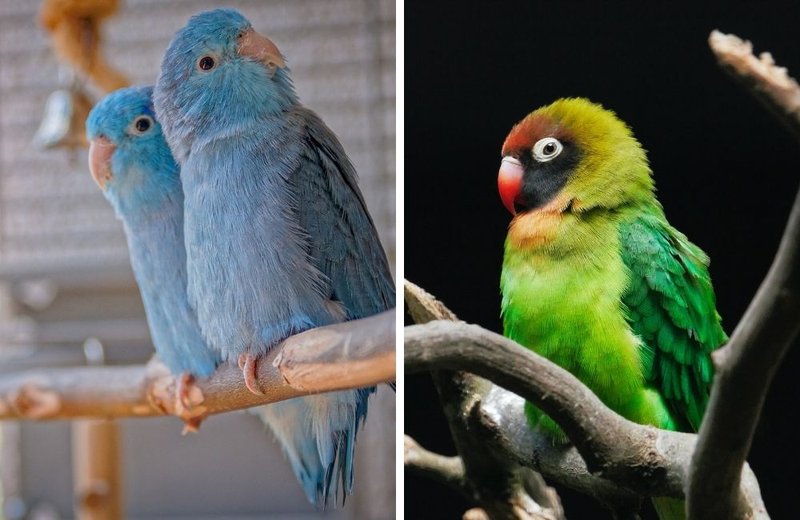
Imagine you’re at a lively bird fair, surrounded by chatter and chirps. You spot a lovebird fluttering around, gleefully interacting with its owner. Next to it, a similar-looking bird draws your eye. Is it another lovebird, or a different species altogether? Here’s the thing: while lovebirds are charming and quirky, they share traits with several other species. In this guide, we’ll dive into the differences between lovebirds and other birds that resemble them.
What Are Lovebirds?
Let’s start with the lovebird. These small, sociable parrots belong to the genus *Agapornis*. The name “lovebird” reflects their affectionate behavior, especially with their partners. Lovebirds are known for forming strong bonds, not just with each other but also with their human companions. They come in several varieties, like the Peach-faced and Fischer’s lovebird, each displaying unique colors and personalities.
Lovebirds typically grow to about 5 to 7 inches long and have a compact build. Their feathers can be a beautiful blend of greens, yellows, and blues, adding a splash of color to any home. Honestly, their playful antics and curious nature can keep you entertained for hours. You might find them chasing each other around a perch or preening their partner in a cozy, affectionate moment.
Comparing Lovebirds to Parakeets
One of the birds often confused with lovebirds is the parakeet, which may seem similar at first glance. Parakeets, particularly the budgerigar variety, are about the same size as lovebirds. However, the main difference between them boils down to personality and social structure.
While lovebirds are known for their intense bonding with their partners, parakeets can be a bit more independent. They are social birds, yes, but they often enjoy mingling with a flock. So, if you’re considering a parakeet, know that they might not cling to you as a lovebird would. Both species enjoy interaction, but parakeets tend to have a more playful, chatty demeanor, while lovebirds display deeper emotional connections.
Another interesting point is their vocalizations. Lovebirds make soft chirps and whistles, delivering a sweet melody. In contrast, parakeets can be quite talkative and might learn to mimic phrases if you spend enough time training them. This leads us to a fun question: which personality aligns better with your lifestyle?
Conures: A Close Contender
Conures are another bird species that can remind you of lovebirds. They come in various sizes, and their colors are just as flamboyant. These birds are generally larger than lovebirds and are known for their gregarious personality and loud vocalizations.
If lovebirds are like a cozy coffee date, conures are more like a lively party! They thrive on interaction and can be quite entertaining. However, this also means they can be more demanding of your time and energy. If you’re considering a conure, be prepared for a bird that wants to be the center of attention.
In terms of care, conures often need more space due to their size and energy levels. They also have a more diverse diet, enjoying fruits, vegetables, and pellets. You might wonder, can you handle the noise and energy of a conure compared to the quieter lovebird?
Canaries: The Soft Singers
Now, let’s take a look at canaries. While they don’t quite share the same affectionate nature as lovebirds, they are often admired for their beautiful songs and bright colors. Canaries are small, usually measuring around 4 to 5 inches long, which makes them slightly smaller than lovebirds.
Unlike lovebirds, canaries tend to be more solitary. They are not as social with humans or other birds, preferring to sing their sweet tunes from their perch. Canaries are a great choice if you’re looking for a bird that requires less hands-on interaction. They do, however, need a stimulating environment with toys and opportunities to fly around safely.
So, if you love the idea of a pet bird but aren’t quite ready for the companionship of a lovebird, a canary’s gentle song might be just the right fit for your home. Plus, they often have vibrant colors that can brighten up your space, too!
The Unique Charm of Finches
Finches are another bird breed that might catch your interest if you’re drawn to lovebirds. These small, social birds are known for their vibrant plumage and lively chatter. Like canaries, finches prefer to live in groups, which means they thrive in a community rather than as solo pets.
Finches are often smaller than lovebirds and have a more delicate appearance. Their songs are cheerful and varied, creating a delightful soundtrack in your home. However, they don’t enjoy being handled as much as lovebirds do. Instead, they express their happiness through chirps and flits around their aviary.
If you love the idea of a lively, colorful bird that communicates through song rather than cuddles, finches might be the right choice for you. They can fill your space with soft sounds and bring a sense of cheer without the need for a lot of direct interaction.
Final Thoughts on Choosing the Right Bird
So, what should you take away from this exploration of lovebirds and their avian cousins? Each bird species has its own personality and care requirements, so the best choice depends on your lifestyle, living situation, and personal preferences.
Lovebirds, with their affectionate nature and colorful presence, make fantastic pets for those who want a bird that will bond closely with them. On the other hand, if you’re looking for a bird that can provide beautiful music or enjoy a more laid-back lifestyle, canaries or finches might be a better fit.
As you weigh your options, consider what you want from a pet bird. Understanding these differences can help you make an informed decision that leads to a happy, harmonious home for you and your new feathered friend. Happy bird-choosing!

